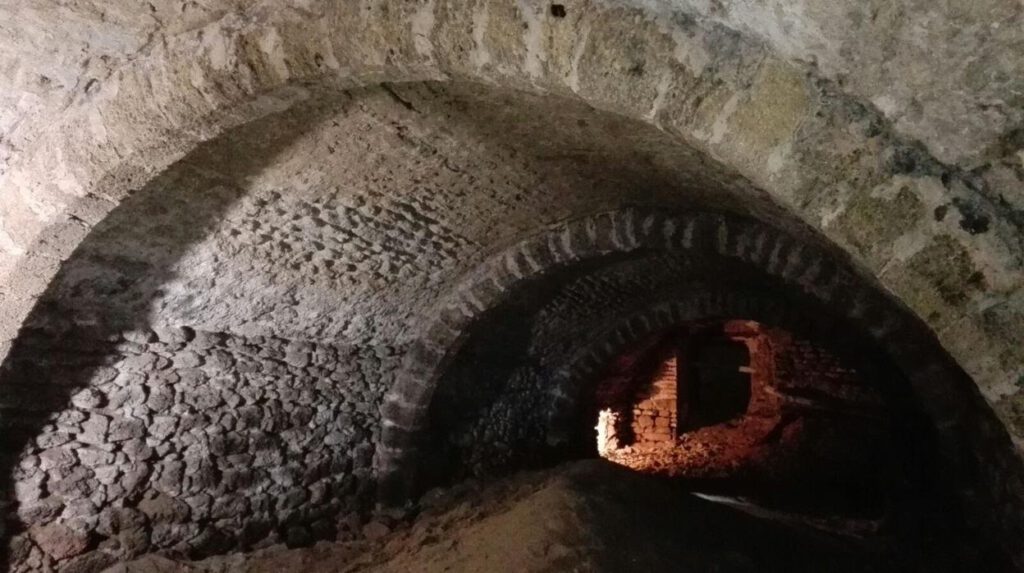Its walls house a church with a Visigothic crypt from the 7th century of incalculable heritage value and a mosque-fortress.

It all started with a window that overlooks the courtyard of the Franciscan monastery of the current Sanctuary of the Virgen de Regla de Chipiona. It shows two clearly differentiated parts. The mullion column has eight facets, an eminently Christian symbol, and yet its arches are pointed horseshoes, clearly Muslim. This finding made the archaeologist and professor at the University of Granada, Antonio Ramos Millán, reflect on the origin of the sanctuary, which is much older than previously believed. If the monastery of Nuestra Señora de Regla is dated as a fortress and hermitage donated in 1399 by Alonso Pérez de Guzmán, it could jump back, no more and no less than the 7th century, the Visigoth period of the Kingdom of Toledo. «In the construction, all the solid work was reused and that is what the Almoravids did with the early Christian church that existed here, they built their ribat, a fortified mosque, and later, when they were expelled by the Castilian conquest, the church was then reused again. mosque for the church of the Virgin of the Rule of the Three Hundred, then popularly called La Morenita, “says Ramos.
with arcosolium Next to the window there is a skylight, today as yesterday protected by a wooden lattice, which served as a vent for the Visigothic crypt that Professor Ramos considers to be of incalculable heritage value. «The Visigothic church has two floors, the common low church is practically completely preserved and the crypt is intact. We are facing an architectural vestige that in Spain can be counted on the fingers of one hand and none is preserved like this, "explains the university professor. Only the crypt of San Antolín in the cathedral of Palencia comes to mind. The underground chamber is 15 meters long and 4.5 meters wide. It is covered with a large barrel vault with three semicircular transverse arches and in its stonework faceted voussoirs can be seen, such as the mullion of the mullioned window. Inside, it conserves a ceremonial water well together with an arcosolium as a funerary niche dug into the wall, used in these first churches to contain the relics of a saint, as an inheritance from the catacombs of the first Christians”, adds Ramos. historical sources Along with these archaeological discoveries, the research of the University of Granada has also made other discoveries. The church and the ribat could be identified in the historical sources with their proper names. In the late Latin of the 7th century appears the church of the Nono Monastery founded by San Fructuoso, mentioned in the Vita Fructuosi. «Nono could take the name because it was the ninth monastery founded by the saint. This was a double monastery, of monks and nuns, the second started with the nun Benedicta. San Fructuoso lived in the monastery for about five years hidden and there he was arrested by King Chindasvinto around the year 651, and brought to his presence at the royal seat of Toledo. The monastery itself was the civic center of the place. Its economy was communal, collectivized and formed an exotic monastic town, "he adds. In the Arab administration, the Visigothic monastic settlement became a protected population like all the Mozarabías of al-Andalus. This originated the name of Chipiona (name of Mozarabic finish). It disappeared like almost all the Sevillian mozarabías with the great expulsion of the Christians from al-Andalus in 1126 by the Almoravid administration. The same thing that happened to the Mozarabía de Triana in Seville. It was then this first Chipiona converted into the Ribat de Las Mezquitas, whose name is collected in classical Arabic in the great geography of al-Idrisi. The patrimonial importance of these findings, even as possible national monuments, has aroused a zeal on the part of the citizens. In fact, the Cultural, Spiritual and Tourist Association of the Sanctuary of Regla de Chipiona is already working with studies and conferences on the subject. News obtained from: https://sevilla.abc.es/andalucia/cadiz/sevi-joyas-ocultas-santuario-virgen-regla-chipiona-201908312153_noticia.html?fbclid=IwAR3gN9RKV_PbEl5p1r5dM-eBCNeWC8pr59fe4ORhO_0TdwWDT3qXKP4mt5w

